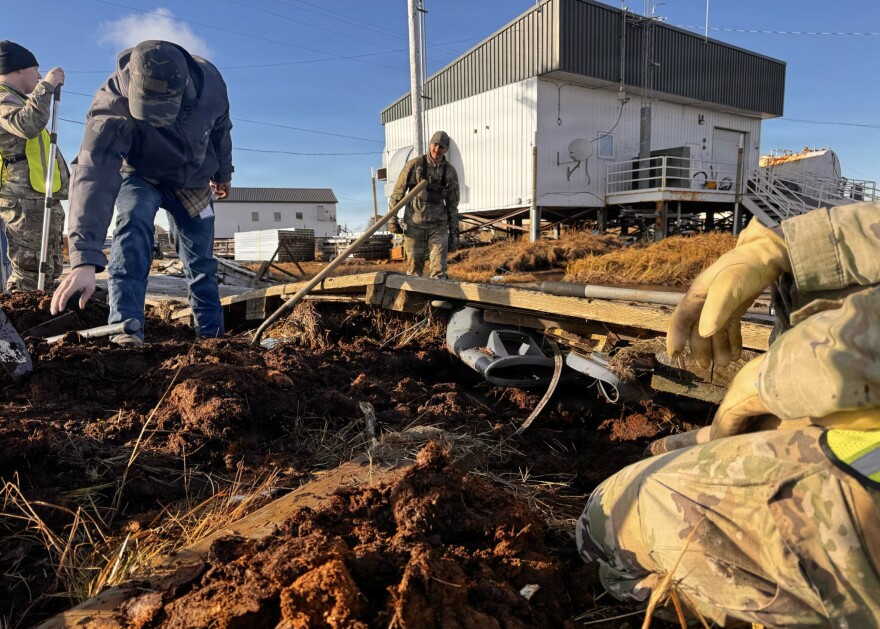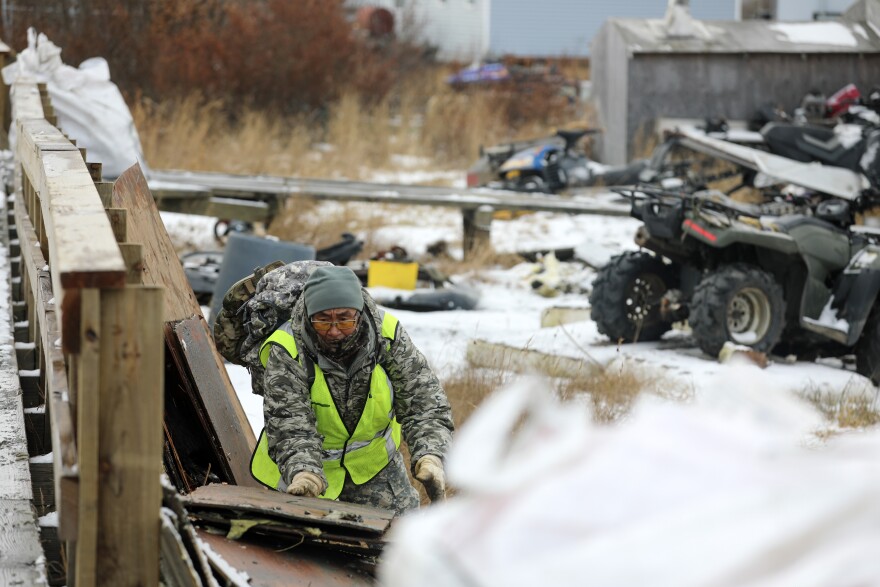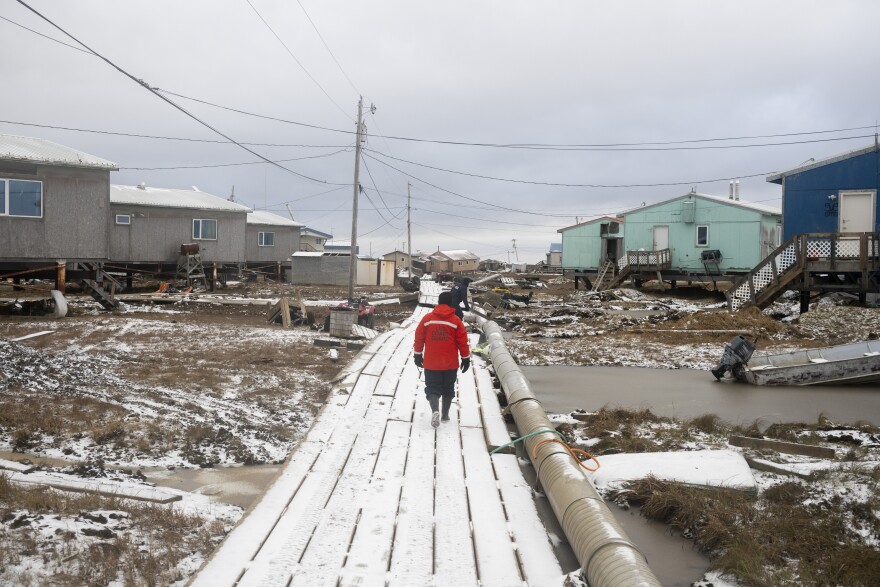Last week marked one month since the remnants of Typhoon Halong devastated communities in Western Alaska with high winds and flooding.
The scale of the destruction in the remote, isolated region is still only starting to emerge.
As of Thursday, the state Department of Homeland Security and Emergency Management reported that 471 homes sustained major damage. Another 208 were destroyed. Among the 3,472 homes surveyed across the affected area, only about a quarter made it through the storm undamaged.
The storm killed one person and left two more missing.
The Association of Village Council Presidents, a regional tribal government consortium, reported that more than 50 communities saw impacts from the storm, with more than a dozen reporting serious damage.
The damage, especially in the villages of Kipnuk and Kwigillingok, led residents to evacuate in what the Alaska National Guard called the largest airlift in the state's history. After rescuing 51 people in the storm's immediate aftermath, first responders evacuated nearly the entire population of Kipnuk and Kwigillingok. More than 500 people are sheltering in hotels, and their long-term future remains in question.
Kipnuk
In Kipnuk, only the school and a handful of houses made it through the record flood in good shape. The vast majority of structures were damaged or destroyed — some 90%, according to the state Department of Transportation and Public Facilities.
James Paul is one of a small group of locals remaining in Kipnuk and working on the immense task of rebuilding. There have been some small wins, he said — for one thing, the local school, still serving as a hub for the relief effort, is also now connected to village electricity. Some street lights are even on.
"They have been making good progress every day," he said in a phone interview earlier this month.
But there's a lot left to do. The community's water system is still offline, and most homes don't have power.

Meanwhile, Paul said, aid is surging in. Cargo planes drop off heavy equipment and building supplies.
"Every agency and everybody that comes out here, I think has been really helpful," he said. "They want to help, and I can't say enough (about) all the help we're getting."
A staggering amount of aid has been flowing to the region from governments, nonprofits and the private sector.
But it likely won't be enough for large numbers of residents to return this winter. Paul said his future is uncertain.
"I'm not sure about that," he said. "I want to keep working as long as I can stay here."
But another resident, Benjamin Kugtsun, said he had no plans to leave — at least, as long as they keep making progress.
"As long as we've got power from our power plant and some lights that can power up how we've been living, we're not going to leave," he said. "We're going to stay here and work on Kipnuk — rebuilding Kipnuk."
Kwigillingok
In another village devastated by the storm, Kwigillingok Tribal Resilience Coordinator Dustin Evon said there's just too much damage.
"We feel like it's not going to be habitable through the winter," he said.
Locals and aid workers are keeping busy working to restore the homes that can be saved, Evon said, lifting homes back onto their foundations, replacing insulation soaked by the flood, restoring water and power and so on.

But once the sun goes down, he said, Kwig feels like a ghost town.
"It feels empty, and it's not as lively as it used to be before the storm," he said.
For now, the focus is on restoring homes in place, but the long-term future for the village is miles away. The tribe's members voted in the weeks after the storm to officially relocate about 20 to 25 miles northeast to higher ground, Evon said.
"A lot have said that if a complete rebuild happens in Kwig, many don't feel safe coming back," Evon said.
But financing that relocation, which could cost tens or hundreds of millions of dollars, will be a challenge.
Bryan Fisher, director of the Alaska Division of Homeland Security & Emergency Management, said finding funding for relocation will take time. At a town hall meeting in Anchorage this week, he said that the emergency funding the communities have access to now can be used for rebuilding homes and infrastructure and making them more resilient. The relocation work will have to be addressed with different types of funding later on, he said.
"The programs that we have to respond and recover from Typhoon Halong in this disaster will not relocate the communities. They're intended to repair and replace damaged infrastructure, homes, personal property, subsistence, gear and equipment from the storm," he said. " However, we will be working with all of the agencies and the councils to talk about what we can do to support your desire — if you have it — to relocate in the longer term."
Fisher said he hoped the currently available aid funding would at least buy communities time.
Napakiak
The village of Napakiak was already working on relocation to a nearby bluff when Halong hit — what the local tribe calls a "managed retreat" from the eroding banks of the Kuskokwim River. And Walter Nelson, who coordinates that effort, said the vast majority of homes in Napakiak were flooded during Halong. Approximately a dozen residents have yet to return to their homes, he said.
"I'm 65 years old. I've never seen anything like this," he said. "I've talked to our eldest elder. He's never seen anything like this, the aftermath of Halong."
Still, Nelson said he's grateful the damage in Napakiak was not as severe as it was in Kipnuk and Kwigillingok. For now, crews are working to dry out flooded homes, replace insulation and restore heat, he said.
Nelson said the flood underscores just how urgent relocation is — and not just for his village.
"We can't predict Mother Nature, and we can't challenge her," he said.
Tuntutuliak
Around 30 miles southwest, in Tuntutuliak, the most severe damage came in the low-lying part of town along the banks of Qinaq River. Twenty-six people evacuated, at least a dozen homes were knocked from their foundations, and large sections of boardwalk in the roadless community were ripped away by the storm surge. Elder Henry Lupie said that nearly all of the community's traditional steam baths were flooded or displaced.
"We need steam house(s). We don't have bath and showers readily available in homes," Lupie said.

Lupie said most of the oil-fired heaters in the community have been repaired or replaced. He said the volunteer and agency-led efforts to tear out and replace wet insulation have made multiple homes livable through the winter.
Floodwaters destroyed numerous freezers full of subsistence foods, forcing residents to shift to winter harvests — ice fishing for lush and setting black fish traps, Lupie said. He said his son was among the first residents to harvest a moose under an emergency hunt opened by the state in early November, and that others are waiting for thicker ice to do the same.
"We're just now cutting it up and passing it to the ones down in the lower village … and the ones from Kwigillingok, evacuees," Lupie said.

Quinhagak
Further south, the Kuskokwim Bay community of Quinhagak dodged the worst effects of the storm.
"We are fortunate that our community was not devastated and acknowledge that the communities across the bay have a lot more needs than we do," Mayor Jerilyn Kelly wrote by email.
Nevertheless, Quinhagak saw erosion of as much as 60 feet along miles of beach. The storm surge brought the shoreline closer to the community's already threatened sewage lagoon. It also destroyed unexcavated portions of a nearby archaeological site, the largest known precontact Yup'ik site in Alaska.
Kelly said that 10 homes were damaged by the storm, and that multiple fish camps, drying racks, smokehouses, and boats were washed away by floodwaters. She said the community's water intake line is still damaged and will need to be replaced after break-up.
Nightmute
Far to the northwest, at least 19 people evacuated after floodwaters inundated homes in the Nelson Island community of Nightmute, roughly 10 miles up the Toksook River, according to the National Guard. The flooding made the riverside community appear as if it were in the middle of the ocean, said Tribal Administrator Clement George.
A month later, rebuilding work is still underway, he said.
"We're rebuilding houses, boardwalks are mostly rebuilt, repaired … I think there's three homes to be demolished," George said.
George said a contractor has finished constructing a temporary landfill on higher ground after the storm pushed water into the community's landfill and sewage lagoon.
George said it's the worst disaster he's ever experienced. The nearby community of Toksook Bay saw the highest wind gust ever measured on Nelson Island, at 100 miles per hour. George said the level of erosion around Nightmute stands out.
"Some of the tundra is folded and the small creeks, they're bigger than before," George said.
At the nearby coastal subsistence camp of Umkumiut, dozens of structures were all but wiped out. The site holds deep cultural importance for many on Nelson Island, and according to George, provides as much as 75% of Nightmute's subsistence needs.
Copyright 2025 Alaska Public Media



